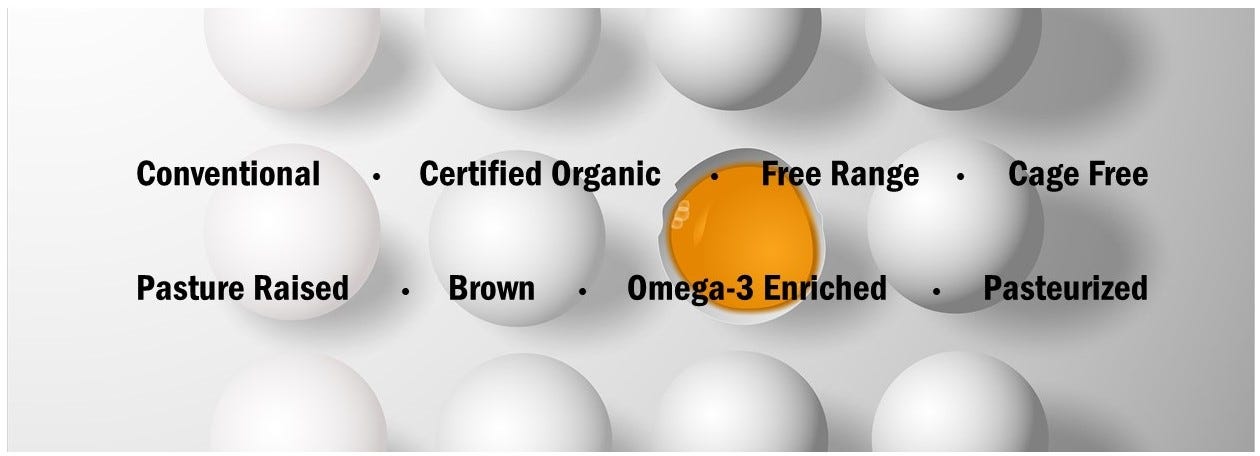Spinach Pie Frittata
All the flavors of spinach pie are packed into this frittata – perfect for breakfast, lunch, or dinner.
It used to be that shopping for eggs was pretty simple. Deciding between small, medium, large, extra-large, and jumbo eggs was about the only choice to be made. Today, the options can be a bit overwhelming. Cage free, certified organic, and pasture raised are just a few terms featured on egg cartons.
The Egg Nutrition Center created a buyer’s guide to help consumers understand what it all means.
CONVENTIONAL EGGS
The most economical and readily available choice, conventional eggs are laid by hens housed in enclosures that also serve as nesting space.
CAGE-FREE EGGS
These eggs are laid by hens that roam in a building, room, or open area that includes nest space and perches. While these hens are not caged, roaming space may be limited.
FREE-RANGE EGGS
Free-range eggs come from hens not housed in enclosures. They are free to roam outside. In addition to eating grains, these hens may forage for plants and insects.
BROWN EGGS
Unless otherwise noted on the carton, these are conventional eggs with a brown shell. The color of the shell does not influence the eggs nutritional value, quality, or flavor. Hens with reddish-brown feathers and red ear lobes lay brown eggs. Hens with white feathers and white ear lobes typically lay white eggs.
CERTIFIED ORGANIC EGGS
These eggs are laid by cage-free or free-rage hens raised on certified organic feed. The hens must be given outdoor access year-round.
PASTURE RAISED EGGS
Pasture raised eggs are from hens that roam and forage on a maintained pasture area. The U.S. Department of Agriculture (USDA) does not recognize this labeling term and therefore, no standards exist.
OMEGA-3 ENRICHED EGGS
These eggs are laid by hens fed a diet rich in omega-3 fatty acids. Commonly available brands typically contain 160 to 250 milligrams of omega-3s per egg. A conventional egg has about 50 milligrams of omega-3s.
PASTEURIZED EGGS
Pasteurized eggs are heated to a temperature that kills pathogens without cooking the egg.
With the exception of omega-3 enriched eggs, there are no real significant nutrient differences in eggs based on the color of the shell or farming method. You will notice a difference in price. More involved production practices mean greater cost. When shopping for eggs to make today’s frittata, I found quite a price range – anywhere from $2.39 for one dozen, large conventional eggs to $8.49 for a dozen organic, pasture raised eggs.
To your health,
Darlene
SPINACH PIE FRITTATA
Yield: 6 servings
Serving Size: one slice
Prep: 15 minutes
Ready: 45 minutes
INGREDIENTS
1 tablespoon olive oil
1 cup diced onion
2 cloves garlic, minced
6 large eggs
1/4 cup reduced-fat sour cream
2 to 3 tablespoons fresh-squeezed lemon juice
1 package (10 ounce) frozen chopped spinach, thawed and squeezed of excess moisture
2/3 cup crumbled feta cheese
1/4 cup grated Parmesan cheese
2/3 cup sliced green onion, tops and bulbs (about 4 green onions)
2 tablespoons fresh minced parsley
1 tablespoon fresh minced dill
1/4 teaspoon kosher salt
1/2 teaspoon black pepper
DIRECTIONS
Preheat oven to 350 degrees. In a 10-inch oven-safe skillet on the stove top, heat oil over medium heat and sauté onion and garlic until the onion is soft, about 3 to 4 minutes.
In a large bowl whisk together eggs, sour cream, and lemon juice until combined. Stir in spinach, feta cheese, Parmesan cheese, green onion, parsley, dill, salt, and pepper. Pour egg mixture into skillet with sautéed onion and garlic and using a spatula, stir gently to combine. Cook the mixture over medium-low heat for 2 to 3 minutes and then transfer skillet to preheated oven.
Frittata baking times vary. Bake until the center is just set; between 15 and 25 minutes. Let stand 5 minutes before serving. Cut into 6 equal slices.
Nutrition Information per Serving
171 Calories, 10 g Total fat, 4 g Saturated fat, 0 g Trans fat, 189 mg Cholesterol, 333 mg Sodium, 6 g Total carbohydrate, 2 g Dietary fiber, 2 g Total sugars, 0 g Added sugars, 11 g Protein, 2 mcg (10%) Vitamin D, 149 mg (10%) Calcium, 1 mg (6%) Iron, 171 mg (4%) Potassium
© 2022 RECIPES MADE HEALTHY BY DARLENE ZIMMERMAN, MS, RD LLC







